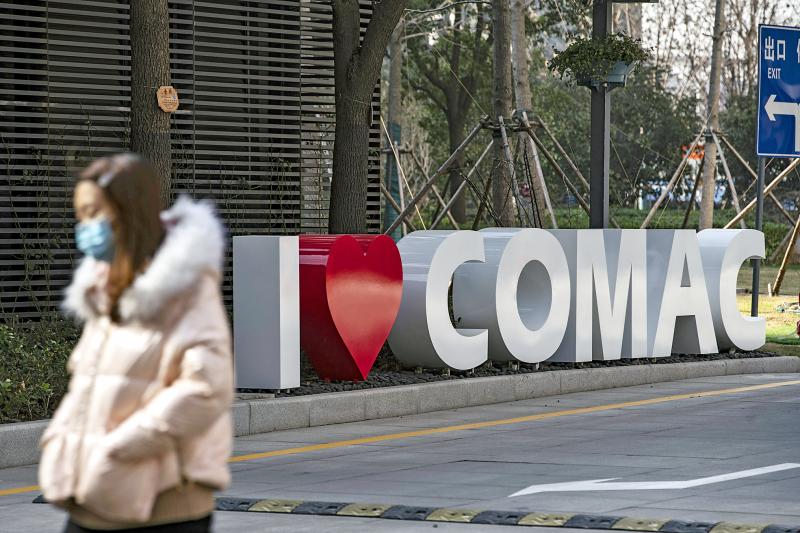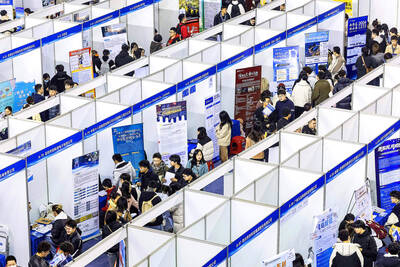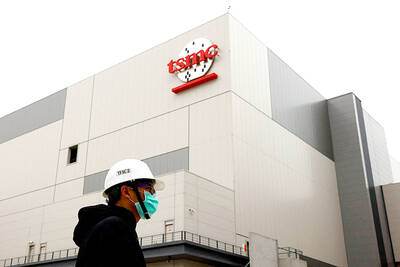While the US and Europe waged a 17-year trade battle over subsidies to Boeing Co and Airbus SE, China poured money into its own commercial aircraft to take on the Western aviation duopoly.
It took a common threat for the US and Europe to finally put an end to their dispute this past week, as the two sides signed a five-year truce suspending tit-for-tat tariffs.
US President Joe Biden made it clear during his visit to Brussels on Tuesday: Washington and Brussels must “work together to challenge and counter China’s nonmarket practices in this sector that give China’s companies an unfair advantage.”

Photo: Bloomberg
For the past four years, state-run manufacturer Commercial Aircraft Corporation of China (COMAC, 中國商用飛機) has run test flights for its 168-seat, narrow-bodied C919 airplane, a potential rival to Airbus’s A320 and Boeing’s B737.
COMAC expects to obtain airworthiness certification from Chinese air traffic regulators this year, coinciding with the 100th anniversary of the Chinese Communist Party.
The aircraft received US$49 billion to US$72 billion in state subsidies, much more than the aid that Airbus and Boeing were given by their governments, US Center for Strategic and International Studies senior adviser Scott Kennedy said.
“The very real problem is that China is manipulating the market in playing Airbus and Boeing against each other and demanding technology transfers as a condition for orders,” said Richard Aboulafia, an aviation expert at Teal Group, a market analysis firm based in Virginia.
China’s air traffic has recovered much faster than elsewhere in the world, as the country brought COVID-19 outbreaks under relative control well before others last year.
Boeing believes that the Chinese market will need 9,360 aircraft in the next 20 years, one-fifth of the world’s total.
It could be a major windfall for the A320 and the 737 MAX, although China has yet to authorize the return of the Boeing aircraft, which was grounded for 20 months in the US following two fatal crashes.
While China remains dependent on Airbus and Boeing aircraft for now, the country’s ambitions to have its own fleet are clear.
“The aeronautics industry is both an instrument of growth and a diplomatic and commercial tool that allows them to have a very comprehensive foreign policy in foreign markets,” said Michel Merluzeau, analyst at AIR, an industry consultancy.
“The Chinese have the technological and industrial skills to make an airplane, there’s no doubt about that,” he said.
“The Chinese are ambitious. They’re very reasonable. They know it will take time,” he said. “They don’t want to take on Airbus and Boeing in 2025.”
The C919 was built with US and European help. Only 14 of the aircraft’s 82 suppliers are Chinese, Kennedy said.
The wings and fuselage are Chinese, but manufacturers in the country have yet to master the skills of building engines or airplane electronic equipment.
“They prepare their industry to meet domestic needs, it would be inferior products, but at least it would be national,” Aboulafia said.
The airplane is heavier than the US and European aircraft, making it less fuel efficient and thus more expensive to operate.
Still, COMAC is racking up customers. The company says it has 815 orders from 28 clients, most from Chinese airlines — although few are confirmed orders.
China Eastern Airlines Corp (中國東方航空) was the first company to make a firm order in March for five aircraft.
Huang Jun (黃俊), professor at the school of aeronautic science and engineering of Beihang University in Beijing, said that the C919 would not be a game changer.
It might be cheaper than its rivals and create an “ABC pattern” in China, with Airbus, Boeing and COMAC operating in the country.
“We just hope we can join this market and occupy a certain market share,” Huang said.
For Airbus chief executive Guillaume Faury, COMAC “will progressively become a decent player.”
“So we will grow probably from a duopoly to a ‘triopoly’” by the end of the decade for single-aisle aircraft, he said.

Stephen Garrett, a 27-year-old graduate student, always thought he would study in China, but first the country’s restrictive COVID-19 policies made it nearly impossible and now he has other concerns. The cost is one deterrent, but Garrett is more worried about restrictions on academic freedom and the personal risk of being stranded in China. He is not alone. Only about 700 American students are studying at Chinese universities, down from a peak of nearly 25,000 a decade ago, while there are nearly 300,000 Chinese students at US schools. Some young Americans are discouraged from investing their time in China by what they see

Taiwan Semiconductor Manufacturing Co (TSMC, 台積電), the world’s largest contract chipmaker, yesterday reported record sales for the first quarter, which analysts attributed to solid demand for emerging technologies. Consolidated revenue totaled NT$592.64 billion (US$18.51 billion) in the January-to-March period, up 16.5 percent from a year earlier, but down 5.26 percent from the previous quarter, TSMC said in a statement. The first-quarter revenue beat analysts’ average projection of NT$579.5 billion, Bloomberg News reported. That performance lends weight to expectations that the world’s most valuable chipmaker would return to solid growth this year after weathering a post-COVID-19-pandemic cratering of smartphone and computer sales. TSMC is budgeting

MAJOR DROP: CEO Tim Cook, who is visiting Hanoi, pledged the firm was committed to Vietnam after its smartphone shipments declined 9.6% annually in the first quarter Apple Inc yesterday said it would increase spending on suppliers in Vietnam, a key production hub, as CEO Tim Cook arrived in the country for a two-day visit. The iPhone maker announced the news in a statement on its Web site, but gave no details of how much it would spend or where the money would go. Cook is expected to meet programmers, content creators and students during his visit, online newspaper VnExpress reported. The visit comes as US President Joe Biden’s administration seeks to ramp up Vietnam’s role in the global tech supply chain to reduce the US’ dependence on China. Images on

New apartments in Taiwan’s major cities are getting smaller, while old apartments are increasingly occupied by older people, many of whom live alone, government data showed. The phenomenon has to do with sharpening unaffordable property prices and an aging population, property brokers said. Apartments with one bedroom that are two years old or older have gained a noticeable presence in the nation’s six special municipalities as well as Hsinchu county and city in the past five years, Evertrust Rehouse Co (永慶房產集團) found, citing data from the government’s real-price transaction platform. In Taipei, apartments with one bedroom accounted for 19 percent of deals last